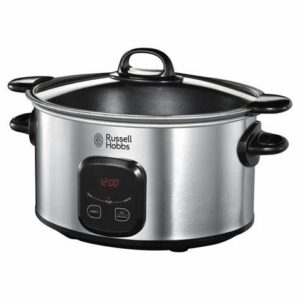
Slow Cooker Review
We love them for their ease, the ability to feel like we have dinner under control. The satisfaction of placing everything uncooked in the morning and having dinner ready at night without really having to do much at all. I personally love my slow cooker!
Slow cookers most commonly have two types of inserts, non stick or ceramic. I prefer to avoid the non stick option as they have many chemicals in the non stick coating. Ceramic would be my preferred choice. In some instant pots, you can find stainless steel inserts, but I’m yet to find this option in a traditional slow cooker.
Up until now I did not know that some ceramic inserts can contain lead. They do so to give products an attractive shine. Lead is added via the glaze or because it comes in the raw materials used to make the ceramic cookware. Ceramic ware is glazed before entering a kiln to bake. If ceramics are baked for long enough, at hot enough temperatures, they may still be safe, but if not, the lead can leach into food. These days many manufacturers have switched to lead free glazes.
For glazes, it is very standard now for Industrial manufacturers to employ stains as their preferred glaze method. Stains are used as an alternative to employing metal oxide powders and have many advantages. Stains are inherently much safer to use than raw metal oxide colorants because they are sintered (which means particle to particle bonding and packing) as colourant/stabiliser blends and much less is needed which makes it a safer option.
Fortunately, stain manufacturers are addressing these problems. They have done the endless blending to achieve a myriad of different color shades, and they have established stable “oxide systems”, which function more reliably. Many well documented oxide groupings have evolved (e.g. chrome-iron-cobalt-nickel black).
Most manufacturers keep these detailed mixes propitiatory because they have made their perfect colour unique to their brand.
The best prevention for leaching on food surfaces is to use non coloured glazes. Interestingly leaching is almost guaranteed if metal oxides are added, not stains.
Ceramic glazes are not as universally inert and stable as many people think. Some glazes are dramatically more soluble than others. Glazes can be leached by acids and bases.
Fact: Product safety Australia has never recalled a slow cooker due to unsafe levels of lead.
Health WA states on their website items contain lead, ceramic cookware, glazes and glass; when improperly fired and used in cooking or to store acidic, hot or alcoholic foods.
In Australia, we have some regulations to protect us from lead, especially when it is connected to the consumption of food. Customs Regulations 1956 Regulation 4E “prohibits the importation of glazed ceramic ware used in connection with the storage or consumption of food for human consumption if it exceeds the acceptable release levels of heavy metals”
Basically all slow cookers are imported, especially from China. A sample from each type of ceramic ware in the shipping container is “supposed” to be tested for lead and cadmium by customs but often they are not all tested.
Because the Australian Customs risk management program is focussed on manufacturers, individual shipments are often not tested. Even when ceramicware imported into Australia is selected for laboratory analysis the process is controlled by the ACS. The laboratory report and certificate is issued to the ACS not to the importer. The importer is only advised whether the product passed or failed. This is so vastly different to European standards.
The older the slow cooker, the more lead leaching potential it has. Microscopic cracks and general wear and tear of the inner ceramic pots are concerns. Slow cookers from the 1990s should be swapped for a new unit.
Many manufacturers are now moving away from lead glazes and using lead free glazes in their manufacturing this is why purchasing new is best.
Some tips when choosing a slow cooker:
•Avoid really old slow cookers or second hand
•Stick to quality brands
•Ring or email the manufacturer and ask questions about the glaze, if it made of stain or metal oxides and ask if it’s certified lead free?
•The absolute best option is to invest in a slow cooker with a stainless steel or glass insert.
•There are recommendations to avoid cookware made in China as they have less regulation around lead safety, however almost all slow cookers are made in China.
•Avoid ceramic colours red, yellow and bright orange due to the fact that lead can be used to intensify these colours.
•Avoid searing slow cookers as they almost always have an aluminium non stick coating. If this is scratched Aluminium can leech into your food.
•Check for any certification. FDA, LFGB, EFSA on the box before purchase.
•Check if it has California’s proposition 65 labelling warning and avoid if it does.
What can we do with our existing Slow cookers?
Here are some tests you can do yourself to see if your glaze is compromised.
Vinegar Test: Fill a glazed container half full of vinegar and leave it for several days. If the vinegar turns yellow, this is an indication of lead release.
Lemon Slice Test: Lemon juice is more acidic than vinegar. Keep a lemon slice against a glazed surface for several days. To make sure that it stays wet envelop the whole thing in plastic wrap. If needed, put a weight on top to keep the lemon in contact with the surface.
Check for any chips, cracks, hairline cracks and discolouration.
Brand recommendations:
The only brand that responded to me after emailing approximately 10 well known brands.
1) Russell Hobbs- They have testing reports proving there is no extra lead or cadmium, in the ceramic, glaze or glass.
2) Crockpot state on their website their glaze is lead free.
3) Breville have a slow cooker with a stainless steel insert.
Happy to add more brands of anyone knows of any that fit my criteria.

